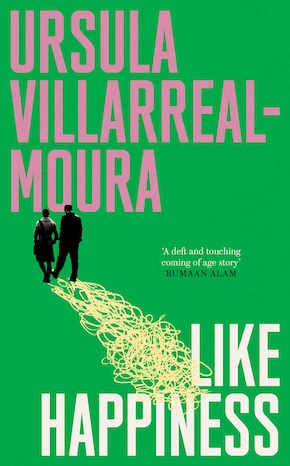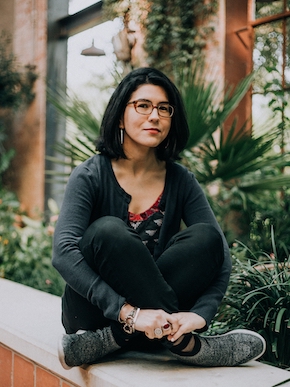Anatomy of an obsession
by Ursula Villarreal-Moura
You’re likely wondering what all this is about – my aim in contacting you. It’s been three years since rain flicked our glasses as we stood inches apart and I stared at your quivering upper lip, which always reminded me of the tilde: ~.
Last week, a journalist contacted me. Since I appeared in a number of online photos with you, it wasn’t long before the media identified me. I learned that a young woman in Upstate New York named María Luz has leveled serious accusations against you. She claims you two met years ago at a library reading you gave in Albany. Obviously, I don’t know María Luz like you do, but I believe her. You weren’t that person with me, not exactly, but the fingerprints of our stories are strikingly similar.
Answering the journalist’s questions brought you back into my lens. For years, it’s perturbed me how things ended between us – rashly but with the finality of a guillotine. Even as we stood on that street corner, my heartbeat deafening the roar of city traffic, I knew I had so much to tell you, but the words remained unformed, timid syllables under my tongue.
It’s taken me all this time to come to terms with what happened between us. We spent so many years of our lives traveling together and sharing secrets, yet we were purposely oblivious to certain aspects of each other. I’m writing to you because so much of my life was spent fixated on you. And while I told myself for years that you viewed me with the same intensity, it’s doubtful you ever really saw all of me. I finally see all of you, the parts I admired and the parts I denied existed. And now I need you to do the same. So, Mateo, here is an account from me to you.
Despite the fact that you were my best friend for a decade, there’s a lot you never knew about me. It’s important that you understand who I was before you. Your first book shaped my life, but my fascination with fiction and authors preceded you.
When I was a child, reading was a struggle because my brain refused to learn phonics. In second grade, I started memorizing words out of necessity and piecing them together in chains. After much repetition, comprehension kicked in and sentences began to excite me. Then one day when I was nine, I fell in love with Judy Blume’s Just as Long as We’re Together.
My mother claims that she and my father were sound asleep in the middle of the night when I shuffled into their bedroom in my pajamas.
“What’s wrong, mija?” she asked.
I was nearly crying. I held my hand over my mouth as if to prevent a sob from escaping.
“What? Tell me!” she pleaded.
“I’m worried Rachel’s going to be left out,” I said. “What if Stephanie and Alison ignore her?” I hovered over my mother’s prostrate body and continued sharing my anxieties.
My mother had never heard me speak of girls named Rachel, Stephanie, or Alison, so her mind scrambled to place them. “Nena,” she whispered, “where’d you meet these girls? Do I know their moms?”
“No,” I said, annoyed that I had to explain what I felt was so obvious. “Only I know these girls. They’re in Just as Long as We’re Together.”
“What?”
“The book’s gonna end the wrong way,” I said. “Don’t you understand? Do something!”
Looking back at my childhood, I can see that my subconscious had solved an important riddle – how to counter the loneliness and boredom of being an only child. Inside books I found quietude, a marvelous oasis. I could read stories with such ease that I was reduced to a pulsating mind. Nothing mattered but the stories, my understanding of them, how the stories affected me, and the dreams the stories ignited.
In art history, the term ‘fine arts’ meant work created by fair-skinned Europeans. The Mexican painter Diego Rivera’s impressive murals were highlighted in a textbook chapter, a section my professor chose to skip.”
The problem was that I never fell out of love with reading, or more specifically, with other people’s imaginations. In high school, I realized that nearly every writer I admired was from Massachusetts. Sylvia Plath was the first, followed by Emily Dickinson, then Robert Lowell, Susanna Kaysen, and Anne Sexton. In each of their works, I identified with the suffocating sense of malaise, and in the case of Dickinson, with her isolation and misanthropy. It was a sign, I thought, all these writers hailing from the same area. The logical choice for college was to situate myself near Boston, that fault line of literary genius.
This daydream of mine included finding a like-minded friend who’d be interested in making the pilgrimage with me to McLean to visit the legendary psychiatric hospital where my heroes had recuperated from their mental breakdowns. Together we would eat tuna fish sandwiches and split a thermos of hot coffee, just like Esther Greenwood in did The Bell Jar. Our lives would imitate art, or so I’d hoped.
In my first semester at Williams College, I realized the literary canon was an exclusive club of white, predominantly well-to-do Americans and Brits. You might want to take credit for my awakening, but the credit doesn’t belong to you. I reached this conclusion before I read your book or had ever heard of you.
What became undeniable for me as an English and art history dual-degree student was that syllabi at Williams were homogenous. My diet consisted of the Brontës, Thomas Hardy, Ford Madox Ford, Jane Austen, Charles Dickens, and occasionally Henry James or Oscar Wilde.
In art history, the term “fine arts” meant work created by fair-skinned Europeans. Nearly every art movement chronicled in my textbooks had roots in the United States or Western Europe. Initially, the Clark Institute, a museum in walking distance from campus, had tantalized me. After a few visits, though, its silverware collection and ancient paintings almost convinced me that art spaces were only for the affluent. The Harlem Renaissance painter Jacob Lawrence was the only Black artist I learned about in depth. The Mexican painter Diego Rivera’s impressive murals were highlighted in a textbook chapter, a Latin American section that my professor chose to skip.
I hungered for writers and painters to teach me something I didn’t know about desire or consciousness. For fun, I read Prozac Nation by Elizabeth Wurtzel, Wasted by Marya Hornbacher, and the somewhat risqué Oranges Are Not the Only Fruit by Jeanette Winterson. I lived in Sawyer Library, thumbing through shelves, searching for art books containing work by Basquiat or Leonora Carrington.
My first two years of college, I wanted to be brought into the fold so badly that I took a number of risks. Sophomore year, I showed up uninvited to a couple of parties only to quickly learn my lesson. To my disappointment, the like-minded friend of mine – the one who would accompany me to McLean – never materialized. She or he was supposed to be the right ratio of similar to me versus different from me. But true to my inner Emily Dickinson, I preferred the hemisphere of my thoughts, and in my last two years, I made little to no effort to befriend peers.
You could say reaching out to you was another limb I crawled out on in hopes of a best-case scenario. Had I developed healthy friendships at Williams, I doubt I would have sought out a relationship with you.
from Like Happiness (Pushkin ONE, £16.99)
—

Ursula Villarreal-Moura was born and raised in San Antonio, Texas. A graduate of Middlebury College, she received her MFA from Sarah Lawrence College where she was a VONA/Voices fellow. Her stories, essays and reviews have appeared in magazines including Tin House, Catapult, Washington Square, Story and Bennington Review. Her writing has been nominated for Best of the Net, Best Small Fictions, a Pushcart Prize, and longlisted for Best American Short Stories, and she is the author of the flash fiction collection Math for the Self-Crippling. Like Happiness, her first novel, is published by Pushkin ONE.
Read more
ursulavillarrealmoura.com
@PushkinPress
Author photo by Levi Travieso

